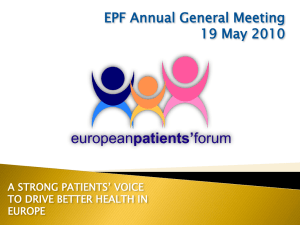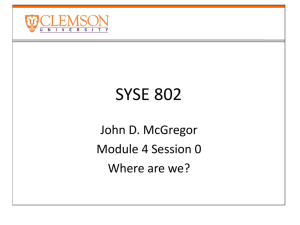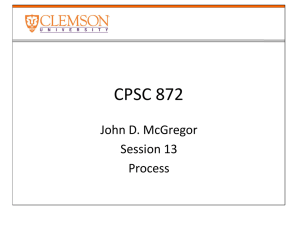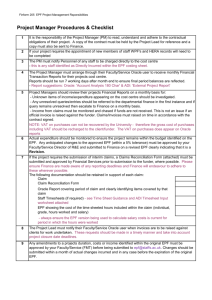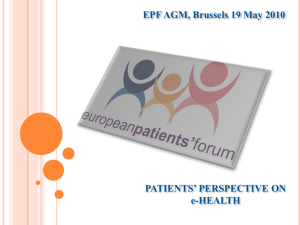A Customizable Methodology for the Model-driven Engineering of Service-based System Landscapes
advertisement
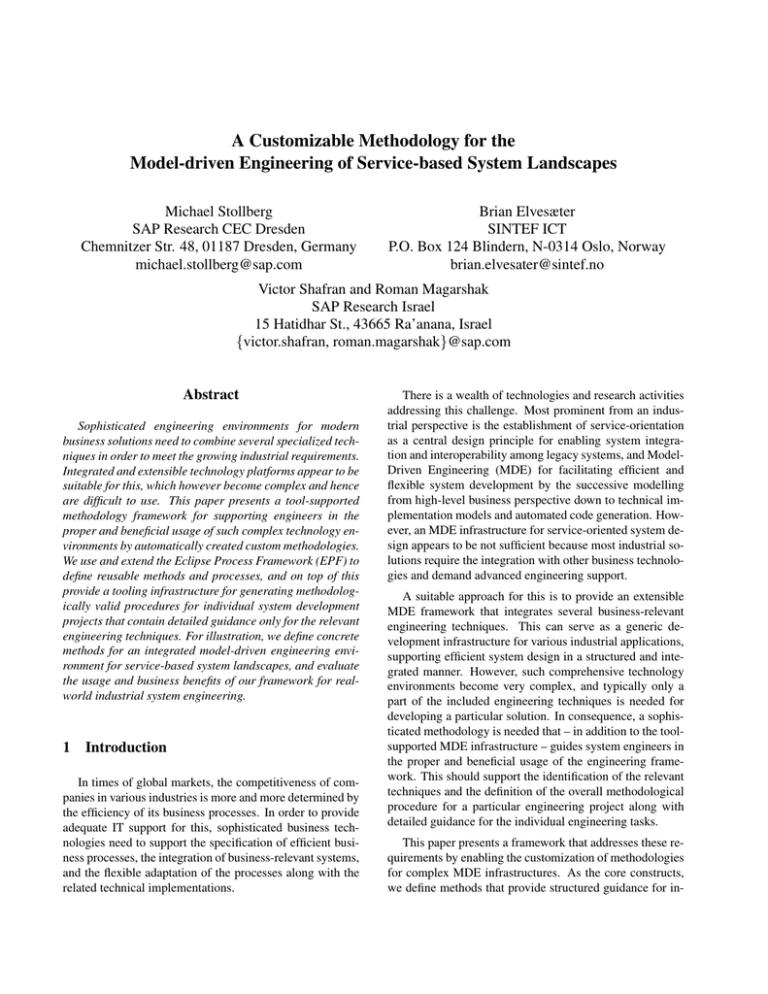
A Customizable Methodology for the
Model-driven Engineering of Service-based System Landscapes
Michael Stollberg
SAP Research CEC Dresden
Chemnitzer Str. 48, 01187 Dresden, Germany
michael.stollberg@sap.com
Brian Elvesæter
SINTEF ICT
P.O. Box 124 Blindern, N-0314 Oslo, Norway
brian.elvesater@sintef.no
Victor Shafran and Roman Magarshak
SAP Research Israel
15 Hatidhar St., 43665 Ra’anana, Israel
{victor.shafran, roman.magarshak}@sap.com
Abstract
Sophisticated engineering environments for modern
business solutions need to combine several specialized techniques in order to meet the growing industrial requirements.
Integrated and extensible technology platforms appear to be
suitable for this, which however become complex and hence
are difficult to use. This paper presents a tool-supported
methodology framework for supporting engineers in the
proper and beneficial usage of such complex technology environments by automatically created custom methodologies.
We use and extend the Eclipse Process Framework (EPF) to
define reusable methods and processes, and on top of this
provide a tooling infrastructure for generating methodologically valid procedures for individual system development
projects that contain detailed guidance only for the relevant
engineering techniques. For illustration, we define concrete
methods for an integrated model-driven engineering environment for service-based system landscapes, and evaluate
the usage and business benefits of our framework for realworld industrial system engineering.
1
Introduction
In times of global markets, the competitiveness of companies in various industries is more and more determined by
the efficiency of its business processes. In order to provide
adequate IT support for this, sophisticated business technologies need to support the specification of efficient business processes, the integration of business-relevant systems,
and the flexible adaptation of the processes along with the
related technical implementations.
There is a wealth of technologies and research activities
addressing this challenge. Most prominent from an industrial perspective is the establishment of service-orientation
as a central design principle for enabling system integration and interoperability among legacy systems, and ModelDriven Engineering (MDE) for facilitating efficient and
flexible system development by the successive modelling
from high-level business perspective down to technical implementation models and automated code generation. However, an MDE infrastructure for service-oriented system design appears to be not sufficient because most industrial solutions require the integration with other business technologies and demand advanced engineering support.
A suitable approach for this is to provide an extensible
MDE framework that integrates several business-relevant
engineering techniques. This can serve as a generic development infrastructure for various industrial applications,
supporting efficient system design in a structured and integrated manner. However, such comprehensive technology
environments become very complex, and typically only a
part of the included engineering techniques is needed for
developing a particular solution. In consequence, a sophisticated methodology is needed that – in addition to the toolsupported MDE infrastructure – guides system engineers in
the proper and beneficial usage of the engineering framework. This should support the identification of the relevant
techniques and the definition of the overall methodological
procedure for a particular engineering project along with
detailed guidance for the individual engineering tasks.
This paper presents a framework that addresses these requirements by enabling the customization of methodologies
for complex MDE infrastructures. As the core constructs,
we define methods that provide structured guidance for in-
dividual engineering tasks, a matrix structure for organizing the methodology content, and a set of partial processes
that define suitable engineering procedures with mandatory
and optional methods and the dependencies among them.
We use and extend the Eclipse Process Framework (EPF)
for implementing the methodology framework, and provide tool support for creating workable engineering procedures that are customized for particular system engineering projects. While the methodology framework is in general applicable to various integrated engineering environments, we illustrate it for an extended MDE infrastructure
for service-based system engineering throughout the paper.
The paper is structured as follows: Section 2 introduces
the extended MDE infrastructure for service-based system
engineering. Section 3 specifies the methodology framework and its implementation in EPF, and Section 4 defines concrete methods for the extended MDE infrastructure
and illustrates the tool-supported creation of customized
methodologies for this. Section 5 evaluates the methodology within real-world industrial use cases, and Section 6
positions our approach within related work. Finally, Section 7 concludes the paper.
2
Extensible MDE Infrastructure
Service-based System Engineering
for
In order to motivate the need for customizable methodologies, the following introduces an MDE framework for
service-based system landscapes that integrates several
business-relevant engineering techniques and has been developed in the European research project SHAPE. Referring
to [15] for further details, we here provide a brief overview
that appears to be sufficient for the purpose of illustration
throughout this paper.1
Figure 1. MDE for Service-based System Engineering – Overview
1 SHAPE
Project Website: www.shape-project.eu.
The aim is to provide an integrated infrastructure for the
model-driven development of service-based system landscapes with support for various business-relevant technologies that have been identified in industrial use cases.
Figure 1 provides a high-level overview of the framework. It follows the OMG Model Driven Architecture
(MDA) approach that distinguishes three levels for modelling IT systems with automated model transformations
between them [10]. Starting at the top, on the computational independent model (CIM) level several prominent
techniques are integrated for modelling the system from a
business perspective. These models are transformed into
skeletons of platform-independent model (PIM) level models that describe the IT system architecture for supporting
the execution of the business processes. SoaML – a UML
Profile and Metamodel standardized by OMG [11] – is used
to describe the services and the overall system architecture.
This is extended with a technique for service customization by creating personalized variants [14], and modelling
techniques for integrating semantic technologies to facilitate the interoperability in heterogeneous environments and
automated service usage (via PIM4SWS [4]) as well as
agent technology to support the design of automated planning systems on top of service-based system infrastructures
(via PIM4Agents [5]). Finally, the architecture models are
transformed into platform-specific model (PSM) level models for specific technology platforms from which the implementation code for the respective execution environments is
generated.
This provides an integrated development environment
for the model-driven engineering of service-based systems
with support for various business-relevant technologies. It
however is very complex, and for most applications only
a part of the available engineering techniques is needed.
For example, the German steel manufacturer Saarstahl AG
wants to integrate an automated planning system that manages the production line with the order and customer management systems; for this, service modelling with SoaML
and the agent extension is needed. At the Norwegian oil &
gas company Statoil, the service customization technique
and the semantic technology extension are needed for integrating legacy systems that work on different industrial
standards and expose a high internal complexity.
In order to support such diverse application scenarios,
we have developed a methodology framework that allows
system engineers to create customized methodologies that
define the overall procedure for a particular system development project and merely contain the relevant engineering
techniques as illustrated in Figure 2. Such a methodological
support on top of the technological infrastructure appears to
be necessary in order to facilitate the proper and beneficial
usage of comprehensive engineering environments as the
one introduced above. The remainder of the paper presents
Figure 2. Methodology: Purpose
Figure 3. Methodology Framework Overview
the technical realization of the methodology framework in
detail, and we discuss its usage and benefits for the mentioned industrial use cases in Section 5.
3
Methodology Framework
This section presents the technical realization of the
methodology framework. We specify the necessary elements and explain the implementation within the Eclipse
Process Framework (EPF), an open-source infrastructure
for defining software engineering processes. While the following focuses on the generic architecture of the methodology framework that can be applied to various MDA engineering frameworks, we will present concrete methodology content and illustrate the customization support for the
model-driven engineering framework for service-based systems introduced above in the next section.
3.1
Element Specification
Figure 3 shows the overall structure of the methodology framework, indicating the EPF constructs used for the
technical implementation as explained below in more detail.
The first main part consists of Methods that provide detailed
user guidance for creating a specific model. A method defines the necessary engineering steps in a structured manner,
and is associated with the following elements: the Model
Types as the resulting output and the models required for
the engineering task, the Roles which perform the method,
and the Tools to be used for this. We distinguish two kinds
of methods, depending on the complexity of the necessary user guidance: while for automated model transformations simple instructions are sufficient, several engineering tasks require a more detailed procedural description e.g. the creation of SoaML models for a complete system
landscape. We further use a Reference Matrix as the underlying organization scheme of the methodology content.
For the service-based system engineering framework introduced above, the vertical axis defines the MDA levels and
the horizontal axis defines the aspects relevant for service
engineering (information, services, processes, rules, events,
organization, goals, and non-functional aspects). The methods as well as the model types are categorized according to
this matrix.
The second main part consists of Methodology Processes that define methodologically workable procedures
over conjoined methods for the separate phases of the intended overall engineering process, therewith providing the
higher-level guidance for how the various engineering techniques can be used. The methodological logic is defined
in terms of processes that define the order of the engineering tasks. Therein, specific methods can be declared to be
mandatory or optional with respect to the intended usage of
the engineering techniques that is supported by the existing tools and model transformations. On this basis, a Custom Methodology can be created that describes the overall
engineering procedure for a particular system development
project. The Methodology Customization Tool supports the
system architect in choosing the appropriate methodology
processes and selecting the relevant methods, and it ensures
that the resulting process description is methodologically
valid with respect to the logic defined in the methodology
processes and the dependencies of the chosen methods. In
addition, the Method Editor supports technology providers
in the specification of valid methodology contents.
3.2
Implementation in EPF
As mentioned above, we have chosen the Eclipse Process Framework (EPF) (see www.eclipse.org/epf)
as the technical infrastructure for implementing the methodology framework. T is an open-source project for defining
customizable software engineering processes, providing a
specification framework for methods and processes along
with editing and content management facilities. As the conceptual framework is similar, the mapping of our framework
to the EPF constructs is straightforward as shown in Figure
troduced above, and then explains the tool support for creating customized methodologies in detail.
4.1
Figure 4. EPF Constructs and Usage
4 (adapted from [6]).
We define our models as work products, and specify the
reference matrix in terms of custom categories in EPF. A
main difference is the differentiation of simple and complex methods. In EPF, detailed stepwise user guidance that
is associated with work products and roles can only be defined as Tasks. These however do not support the definition
of a procedural guidance that consists of several, possibly
iterative engineering tasks. This is needed for our complex
methods, which appear to be necessary in order to properly
guide engineers through more complex engineering tasks
like the modeling of a comprehensive system architecture
in SoaML or the creation of personalized service variants.
We hence specify both complex methods and methodology
processes as Capability Patterns that define processes over
tasks, and distinguish them by additional custom categories
in EPF. Our custom methodologies are presented as Delivery Processes that are defined by aggregating capability patterns and tasks in EPF.
The tool support for our methodology framework is implemented in form of Eclipse plugins on top of the opensource EPF implementation. These implement the necessary algorithms for ensuring the validity of newly created
methodology content and custom methodologies, and guide
the user stepwise via UIs in form of wizards. Unfortunately,
the EPF release (version 1.5.0.2) that was available at the
time of our implementation did not provide an API for the
development of external tools. Hence, our prototypes are
tightly connected to the EPF implementation.
4
Methods and Methodology Processes
The following presents the concrete methodology
content for the extended MDA framework for the modeldriven development of service-based systems as introduced
above in Section 2 (cf. Figure 1). The purpose is to
provide a principle overview on the intended usage of
the various integrated techniques upon which system
architects can select the techniques and methods that
are required for a particular service engineering project.
As a concise overview that appears to be sufficient for
illustration, we here present the methodology processes
that specify workable procedures for using the available
engineering techniques along with the existing tooling infrastructure on each of the distinct MDA levels;
the complete methodology content is available online
(see www.shape-project.eu/download-area/
SHAPE_MethodologyLibrary-M24/).
4.1.1
Integrated Business Modelling (CIM level).
As the most abstract perspective in the MDA approach,
the CIM level is concerned with describing a company or
an economic ecosystem from the business perspective independent of how this is supported by IT systems. For
this, our engineering framework integrates various modelling techniques for business-relevant aspects and enables
efficient modelling by providing integrated tooling support.
Service Engineering Methods and ToolSupported Methodology Customization
After having the defined the generic structure of the
methodology framework, this section illustrates its instantiation and usage for the model-driven engineering of servicebased systems. For this, the following first presents the concrete methods and methodology processes for the extended
MDA framework for service-based system engineering in-
Figure 5. Business Modelling Methodology
Process
Figure 5 shows the methodology process for this. It
supports several parallell entry points: the business analyst can commence with defining a common terminology
Figure 7. System Architecture Modelling
Methodology Process
Figure 6. CIM2PIM Transformations
in form of an ontology, or with the data model and the organizational structure, or with modelling the business motivation in BMM. On this basis, the constituting conditions
and rules of business can be defined, which in turn are the
basis for specifying efficient business processes modelled
in EPC (Event Process Chains) or BPMN. Partial transformations support the sequential use of the various modelling
techniques.
The design of an IT system that properly supports the
business aims requires an appropriate reflection of the processes and requirements described on the CIM level within
the technical system models. Commonly referred to as the
business-IT gap, the main challenge for this is to bridge the
substantially different concepts between the business and
the technical perspective. To support this, our methodology
encompasses automated model transformations defined in
ATL (see www.eclipse.org/m2m/atl/) that generate skeletons of PIM level models from the given CIM level
models as shown in Figure 6. In our methodology, the main
model types are BMPN for business process modelling on
the CIM level and SoaML for service and architecture modelling on the PIM level. Hence, these are defined as the
only mandatory activities in the methodology processes, indicated by bold labelling in the figures.
be used for a particular engineering project. Currently, the
framework integrates the following extended service engineering techniques (see Section 2):
• Extended Service Modelling: behavioural and abstract
functional descriptions in SoaML, serving as the basis for advanced service engineering techniques (e.g.
composition, discovery, mediation)
• Service Variant Modelling: enable customization of
services and simplified consumption by creating preconfigured and personalized variants (see [14])
• MAS Modelling: integrated modelling of multi-agent
systems that work on top of a service-oriented system
landscapes (see [5])
• Semantic Technologies Modelling: extend service and
architecture models with semantic annotations to enable heterogeneity handling and automation of service
consumption tasks (see [4]).
Note that Figure 7 only shows the high-level procedure
for selecting the desired techniques: each activity of the
methodology process is a complex method that consists of
several engineering tasks. Moreover, there are various dependencies among the model types; these are defined via the
input- and output work products of the individual methods.
4.1.3
4.1.2
System Architecture Modelling (PIM level).
Following the requirements and processes modelling from
the business perspective, the PIM level is concerned with
describing the components and architecture of the IT system that shall support the proper and efficient execution.
For this, our MDA framework supports the modelling of
services and service-based architectures in SoaML as well
as the optional usage of additional engineering techniques.
Figure 7 shows the methodology process for the system
modelling on the PIM level. At first, the basic service descriptions and the overall system architecture is modelled
in SoaML. This is the only mandatory activity, and the user
can choose which of the other engineering techniques shall
Implementation Modelling (PSM level).
As the most detailed modelling perspective, the PSM level
is concerned with creating the detailed implementation
models specific technology platforms from which actual
code can be generated. Exploiting the advantages of the
model-driven approach, here the skeletons of the implementation models are generated by fully automated PIM2PSM
model transformations.
In consequence, on the PSM level we define simple
methods that guide developers in refining the generated
skeletons along with recommendations for the deployment on respective execution environments. Currently, our
framework provides PIM2PSM transformations and PSM
methods for the following technology platforms:
• Web Services & Processes: WSDL, XSD, BPEL
• Multi-Agent Systems: JACK, JADE
• Semantic Web Services: WSMO, WSMX, IRS-3.
4.2
Methodology Customization Tool
We now turn towards the creation of custom methodologies for individual system engineering projects. As outlined
before, a custom methodology defines the overall engineering procedure for a specific system development project and
merely contains the relevant techniques and methods out of
the available ones. In order to support system architects
in the creation of custom methodologies, we provide the
Methodology Customization Tool that guides the identification and selection of the relevant engineering methods and
generates a valid overall engineering procedure with respect
to the procedural constraints and dependencies that are defined within the methodology content.
The Methodology Customization Tool is implemented as
an EPF plugin and works on reusable methodology content
as e.g. the methods and processes explained above. As we
shall illustrate for concrete use cases below in Section 5, the
workflow for creating a custom methodology is as follows:
Figure 8. Methodology Customization Tool
coherent overall engineering procedure for the project. The
system architect can optionally refine this – e.g. add specific
instructions for the application scenario – and publish the
custom methodology as a website that provides the central
guidance for all roles involved in the engineering project.
The tool implements the following central algorithms for
supporting the creation of custom methodologies and ensuring their methodological validity:
• Selection of Methods: all mandatory methods are
activated by default; on the transformation levels
(CIM2PIM and PIM2PSM) the methods are activated
for which the required inputs result from the methods
chosen on the preceding level; the user can change this
when the suggested procedure shall not be followed
1. Identification of relevant Engineering Techniques
by analyzing requirements and consulting the methodology & tool documentation
2. Tool-supported Custom Methodology Creation:
• Runtime Validation: user selections are validated at
runtime with respect to the dependencies among the
methods, e.g. methods can not be selected when a
mandatory input does not exists within the preceding
user selections; constraint violations along with resolution options are provided in the user interface
• Configuration of EPF infrastructure for project
• Wizard for selecting required engineering methods with including runtime validation of user
choices (see below)
• Generation of valid custom methodology as EPF
Delivery Process
• Generation of Custom Methodology: generation of an
EPF delivery process that contains the selected methods and defines a coherent overall engineering procedure, including a final validation of method dependencies and the refinement of the procedures.
3. Refinement of custom methodology via EPF editing
facilities (optional)
4. Publication of final custom methodology as a website
(optional).
Figure 8 illustrates the tool support for defining custom
methodologies (cf. step 2). The wizard guides the system
architect stepwise from the CIM level down to the PSM
level. On each page, the user can choose one of the predefined methodology processes and select the specific engineering methods that are required for the project. The tool
ensures the methodological validity with respect to the constraints and dependencies that are defined within the methods and methodologies, and finally generates an EPF delivery process that contains the selected methods and defines a
With this, we provide an easy-to-use tool that allows
system architects to adapt comprehensive engineering technologies to their individual needs. To our knowledge, comparable tools for EPF do not exist at this point in time (see
Section 6 for a more detailed discussion).
5
Evaluation
In order to evaluate the usability and business relevance
of the methodology framework, we have applied it to the
Figure 9. Usage of Methodology Framework
two industrial use cases already mentioned above. In addition, we conducted an online survey where several technology experts and system engineers tested and assessed the
methodology infrastructure, content, and tool support. The
following summarizes the central findings.
The first use case is concerned with optimizing the processes for reservoir and production management at the Norwegian oil & gas company Statoil. The aim is to provide
an integrated solution for optimizing the reservoir performance, intelligent wells and production processes among
the numerous offshore production sites. The processes are
currently performed by production experts supported by an
IT landscape which consists of various isolated and heterogeneous legacy systems of a considerably high complexity.
Hence, the following techniques appear to be suitable for
enhancing the IT-supported business efficiency: techniques
for modelling efficient business processes, services for integrating the legacy systems, semantic technologies for handling the heterogeneous resources, and customization techniques for enabling the effective usage of the complex systems in different application contexts.
Figure 9 illustrates the usage of the methodology framework as explained above. Referring to [7] for details, the
following experiences have been reported. Comprehensive engineering environments as the one presented here are
highly desirable for designing value-added business solutions in an integrated manner. The concept of customized
methodologies is considered to be highly valuable for enabling system engineers to effectively apply the engineering techniques in a specific context. The tool-supported
methodology framework is reported to be well usable by
knowledgeable system architects, and the detailed guided
procedures along with illustrative examples are suitable for
guiding also non-technical experts in performing the engineering tasks. Particularly useful in this scenario are the automated BPMN->SoaML transformation for bridging the
gap between the production and the IT experts, and the
web-publication facility for enabling the collaborative system design among locally distributed engineers.
Similar benefits are reported from the second use case at
the German steel manufacturer Saarstahl AG. Here, the central challenge is to integrate an agent-based planning system
for optimizing the production line capacity with the previously isolated order- and customer management systems.
While the integration is achieved by providing the legacy
systems as services, the main merit of the integrated MDA
framework is that the interactions between the services and
the agents can be specified on the abstract architecture level
(PIM) in such detail that the system implementation can be
generated and maintained with minimal effort [5]. For this,
the detailed methodological guidance is essential to assist
the system engineers in the design. Besides, the customized
methodology is useful for explaining the system benefits to
business stakeholders as well as for coordinating the conjoint system development among the involved departments.
In the online survey, most participants consider the
Methodology Customization Tool to be useful and well designed, and regard the resulting customized methodologies
as a necessary and valuable guidance for individual system
engineering projects. We have already implemented several
suggestions for usability improvements (esp. EPF infrastructure configuration, web-publication). A suggestion for
future improvement is to abstract from the MDA terminology to enhance the understandability of the methodology
for non-technical users.2
6
Related Work
Methodological guidance is commonly considered as an
essential part of Software Engineering, and there is a wealth
of approaches and tools for this. Our framework belongs to
the category of engineering methods that provide guidance
for using a particular technology, which are in general complementary to development methodologies like SCRUM or
more classical techniques that are concerned with planning
and controlling the actual development process [13].
There are numerous methods for technologies related to
service-based system engineering; [3] provides a comprehensive overview. However, these are mostly dedicated to
a specific technology and define static procedures that can
hardly be combined into a comprehensive methodology for
integrated engineering frameworks. To overcome this, our
approach follows the idea of Situational Method Engineering (see [9] and [2]) where reusable method chunks are assembled into customized engineering methods for particular
application scenarios.
Recent approaches aim at providing a generic infrastructure for customizable software engineering methodologies.
2 For details on the survey see:
www.shape-project.eu/
wp-content/uploads/2009/11/shape_d23-final.pdf
Most notably, OpenUP provides an open-source implementation of the Unified Process – a generic framework for
iterative software engineering processes [8] – within EPF,
and the IBM Rational Method Composer (www-01.ibm.
com/software/awdtools/rmc) provides a commercial tool with IBM’s own SoaML-based Service-Oriented
Modeling and Architecture (SOMA) methodology [1]. Although the infrastructures are extensible with methods for
specific engineering techniques, the customization of the
generic processes for a specific scenario is left to manual
inspection. For this, our tool-supported framework provides a complementary infrastructure for selecting the desired methods and automatically creating methodologically
valid engineering procedures.
A specific feature of our framework is that it can be
reused to define customizable methodologies for other engineering technologies. The initial investigation for the ISE
Workbench – an integrated service engineering environment [12] – has revealed that merely methods and methodology processes for the respective techniques need to be defined; the technical infrastructure as well as the Methodology Customization Tool can be used without any changes.
7
Conclusions
This paper has presented a tool-supported framework
for customizing methodologies for comprehensive modeldriven service engineering environments. Such methodological support appears to be highly desirable for integrated engineering environments that are employed for developing modern business solutions.
Following the Situational Method Engineering approach,
we have defined a framework and the necessary constructs
for enabling the customization of reusable method chunks.
The methods and processes are defined within the Eclipse
Process Framework (EPF). On top of this, we provide new
tool support for the automated creation workable engineering procedures that merely contain the techniques relevant
for individual system development projects.
While the presented methodology framework and tool
support is in general applicable to any model-driven engineering technology, we have presented an instantiation for
an extended MDA framework for service-based system engineering. For this, we have defined an integrated set of
reuable methods and methodology processes around BPMN
and SoaML, and discussed its business relevance within two
industrial use cases. For the future, we plan to apply the
framework to other engineering technologies and to align it
with the ongoing EPF developments.
Acknowledgements. This paper is mainly based on
works supported by EU funding under the SHAPE project
(FP7 - 216408) with special thanks to Dmytro Panfilenko,
Christian Hahn, Davide Cerri, Marisa Escalante, and ArneJørgen Berre.
References
[1] J. Amsden.
Modeling with SoaML.
Technical
article, IBM, 2010.
Online:
www.ibm.com/
developerworks/rational/library/09/
modelingwithsoaml-1/index.html.
[2] M. Brinkkemper S., Saeki and F. Harmsen. Assembly Techniques for Method Engineering. In 10th Conference on Advanced Information Systems Engineering, CAiSE’98, LNCS
1413, pages pp. 381–400. Springer, 1998.
[3] B. Elvesæter and S. G. Johnsen (eds.). Model-driven
Methodology and Architecture Specification. Deliverable
D2.1, SHAPE Project, 2009.
[4] D. Fensel, H. Lausen, A. Polleres, J. de Bruijn, M. Stollberg, D. Roman, and J. Domigue. Enabling Semantic Web
Services. The Web Service Modeling Ontology. Springer,
2006.
[5] C. Hahn, C. Madrigal-Mora and K. Fischer. Interoperability
through a Platform-Independent Model for Agents. In K. M.
J. P. Müller and M. Zelm, editors, Enterprise Interoperability II - New Challenges and Approaches. Springer, 2007.
[6] P. Haumer. Eclipse Process Framework Composer. Part 1:
Key Concepts. EPF Documentation, 2007. Online: www.
eclipse.org/epf/composer_architecture.
[7] S. Jacobi (ed.). Case Study Execution and Validation. Deliverable D1.3, SHAPE Project, 2009.
[8] P. Kroll and B. MacIsaac. Agility and Discipline Made Easy:
Practices from OpenUP and RUP. Addison-Wesley, 2006.
[9] K. Kumar and R. Welke. Method Engineering: A Proposal
for Situation-specific Methodology Construction. In Cotterman and Senn, editors, In Systems Analysis and Design : A
Research Agenda, pages pp. 257–268. Wiley, 1992.
[10] S. J. Mellor, K. Scott, A. Uhl, and D. Weise. MDA Distilled
– Principles of Model-Driven Architecture. Object Technology Series. Addison-Wesley, 2004.
[11] OMG. Service oriented architecture Modeling Language
(SoaML) – Specification for the UML Profile and Metamodel for Services (UPMS). FTF Beta 1, 2009.
[12] G. Scheithauer, K. Voigt, V. Bicer, M. Heinrich, A. Strunk,
and M. Winkler. Integrated Service Engineering Workbench: Service Engineering for Digital Ecosystems. In
Proc. of the International ACM Conference on Management
of Emergent Digital Ecosystems (MEDES), 27-30 October
2009, Lyon (France), 2009.
[13] I. Somerville. Software Engineering. Addison Wesley, 8.
edition, 2006.
[14] M. Stollberg and M. Muth. Service Customization by Variability Modeling. In Proc. of the 5th International Workshop
on Engineering Service-Oriented Applications (WESOA09),
Stockholm, Sweden, 2009.
[15] M. Stollberg (ed.). SHAPE Whitepaper. Technical Report, Version 3.2, SHAPE Project, 2010. Online: www.
shape-project.eu/download.
